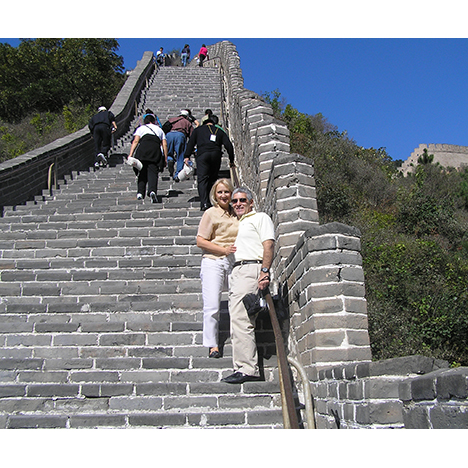I have always been fascinated by Asia, and traveling to Beijing, China was a dream come true.
Sometimes you have an idea of a place in your mind, from books, photographs, and movies, but I was totally unprepared for the beauty of China, and the treasures that awaited me in Beijing.
When Edward F. Nesta and I were planning our trip to China we had thought about splitting our time and visiting multiple cities, however, when we delved into all that there was to experience in Beijing, we decided that for our first trip to China, we would concentrate only on Beijing. After spending eight days in Beijing in October 2006, there is still so much more for us to see that it will require subsequent trips, but we feel that at least we have scratched the surface.
Beijing, located in the northern part of China, is the capital of the People’s Republic of China, covers 16,800 square kilometers, and has a population of 11.28 million. To give you an idea of the size of Beijing, it is the same size as the country of Kuwait. With that said, we had to determine how to best cover the distance and see as much of Beijing as possible.
After researching our options, we selected East Tours, whose motto is “Your China Dream Weaver,” to assist us in weaving our dreams. East Tours provided us with professional personalized service, a private car, driver, and an English-speaking guide, each day during our trip to help us discover the rich cultural history of a gracious country. East Tours also arranged for all of our tickets to the museums and for the cultural venues to ease our entrance without waiting in long lines to purchase the tickets.
East Tours
314 Route 22, West Suite J
Green Brook, NJ 08812
United States
Telephone: +1 732 926 0090
Toll-Free: +1 866 40 CHINA (1 866 402 4462)
Fax: +1 732 926 0333
Email: info@east-tours.com
www.East-Tours.com
When we learned about the gorgeous new hotel the Commune By The Great Wall Kempinski, we knew that we had to experience it. When they say “By The Great Wall,” they are not exaggerating. The hotel, which had its grand opening on September 23, 2006, is located on 8 square kilometers of private land in the Shuigan Mountains, 40 minutes from the Beijing International Capital Airport, and 50 minutes from Beijing city center, and quite literally has the Great Wall as its neighbor. In addition to its tranquil setting that is worlds away from Beijing city center, one of the extra benefits of staying at the hotel is that guests have the opportunity to have a private tour of the Great Wall on the hotel’s property. Taking a private tour of the Great Wall was a most magical, and very memorable part of our trip.
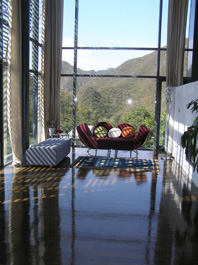
If that is not enticing enough, imagine staying in one of the award-winning design villas with names like The Bamboo House, Forest House, Cantilever House, and The Shared House, with sculpture and paintings by famous artists. Suffice it to say, the Commune By The Great Wall Kempinski is anything but an ordinary hotel.
Combined with the Anantara Spa By the Great Wall, where you can select from a variety of spa treatments, including having treatments on the terrace overlooking the Great Wall, this is definitely a fantasy hotel. After spending our days discovering Beijing, it was wonderful at the end of the day to relax with a Spa treatment.
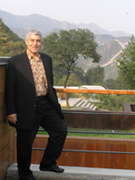 A great hotel needs a great chef, and Executive Chef Nelson Yap is responsible for the creative and visually appealing meals at the Courtyard restaurant and The View. We loved having lunch on the terrace of The View, which has a sensational view of the Great Wall
A great hotel needs a great chef, and Executive Chef Nelson Yap is responsible for the creative and visually appealing meals at the Courtyard restaurant and The View. We loved having lunch on the terrace of The View, which has a sensational view of the Great Wall
For additional information on the Commune By The Great Wall Kempinski, please read the articles in the Hotels and Resorts, Spas, Restaurants, and Chefs’ Recipes sections.
Commune By The Great Wall Kempinski
The Great Wall Exit at Shuigan
Badaling Highway
Beijing
People’s Republic of China
Telephone: (86 10) 8118 1888
Fax: (86 10) 8118 1866
Toll-Free: 00 800 426 313 55 (Europe)
Toll-Free: +1 800 426 3135 (North America)
Email: Reservations.TheGreatWall@Kempinski.com
Email: Reservation@Commune.com.cn
Websites: www.Commune.com.cn
www.Kempinski-TheGreatWall.com
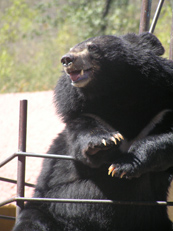 We began our first day of exploring with East Tours with a visit to the Bear Park. Our trip coincided with the national holiday, which was a very exciting time to visit China and experience the country through the eyes of its citizens who were also visiting the famous sights. Here you not only get to see the adorable bears up close, but you are also able to feed them fresh fruit.
We began our first day of exploring with East Tours with a visit to the Bear Park. Our trip coincided with the national holiday, which was a very exciting time to visit China and experience the country through the eyes of its citizens who were also visiting the famous sights. Here you not only get to see the adorable bears up close, but you are also able to feed them fresh fruit.
Just beyond the Bear Zoo is the Great Wall at Badaling where we set out to experience this legendary landmark. The Great Wall of China, built between the 3rd and 17th centuries, stretches for 6,352 kilometers (3,948 miles), is the longest manmade structure in the world, is one of the eight major scenic wonders of the world, and a UNESCO World Heritage Site since 1987.

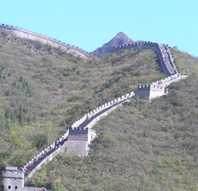 Constructed as a defensive wall, it is a series of steps that lead to watchtowers and barracks that wind like a ribbon over the mountains. The Badaling section of the Great Wall built in 1505 was an important defense for the Ming Dynasty. Our Guide, Mr. Jia Lu put us through our paces on the Great Wall where he told us the famous Chinese quote, “Bú dà Chángchéng fĕi hăo hàn,” (You are not a real man until you have climbed the Great Wall). We climbed the extremely steep section at Badaling for over 4 kilometers (2.5 miles) and were completely captivated as the wall seemingly stretched into infinity in front of us.
Constructed as a defensive wall, it is a series of steps that lead to watchtowers and barracks that wind like a ribbon over the mountains. The Badaling section of the Great Wall built in 1505 was an important defense for the Ming Dynasty. Our Guide, Mr. Jia Lu put us through our paces on the Great Wall where he told us the famous Chinese quote, “Bú dà Chángchéng fĕi hăo hàn,” (You are not a real man until you have climbed the Great Wall). We climbed the extremely steep section at Badaling for over 4 kilometers (2.5 miles) and were completely captivated as the wall seemingly stretched into infinity in front of us.
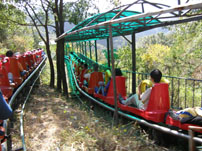 Although many people walk down, Mr. Lu had another surprise in store for us, and we rode the train down from the Great Wall, which was like a slow roller coaster ride, which sure beat walking! Summer Hours: 6:30 am – 7:00 pm, Winter Hours: 7:00 am – 6:00 pm. Admission is charged. Read more about Climbing the Great Wall of China in the Adventures section.
Although many people walk down, Mr. Lu had another surprise in store for us, and we rode the train down from the Great Wall, which was like a slow roller coaster ride, which sure beat walking! Summer Hours: 6:30 am – 7:00 pm, Winter Hours: 7:00 am – 6:00 pm. Admission is charged. Read more about Climbing the Great Wall of China in the Adventures section.
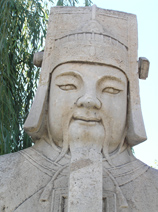 We visited the important Ming Tombs, erected between 1436-1438, where 13 Emperors, 33 Empresses, Imperial concubines, crown princes, and princesses of the Ming Dynasty were buried.
We visited the important Ming Tombs, erected between 1436-1438, where 13 Emperors, 33 Empresses, Imperial concubines, crown princes, and princesses of the Ming Dynasty were buried.
We walked along the willow tree lined walkway with 36 stone animals and statues standing in front of the tombs. The stone animals and statues not only served as a decorative function, but were also the guard of honor when the monarch was alive. The statues include: Meritorious General, Meritorious Official, Civil Official, Civil Official, General, General, Standing Horse, Prone Horse, Crouch Olin, Standing Elephant, Prone Elephant, Standing Camel, Prone Camel, Standing Xiezhi, Standing Lion, and Crouch Lion.

The Ming Tombs received a UNESCO World Heritage site designation in 2003. Hours: 8:30 am – 5:00 pm. Admission is charged.
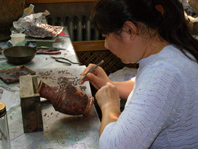 China has many traditional arts, and we visited the Beijing Binbin Handicraft Group to experience the ancient traditional Chinese art of cloisonné, also called enamelware, invented in 607, and highly popular since the Ming Dynasty.
China has many traditional arts, and we visited the Beijing Binbin Handicraft Group to experience the ancient traditional Chinese art of cloisonné, also called enamelware, invented in 607, and highly popular since the Ming Dynasty.
Cloisonné begins with a copper vehicle (plate, vase, etc) with copper wire painstakingly curled by the artist and is then applied using tweezers with glue and solder. The next step is creating the colors ground from minerals from the mountains for the enamel paint, and painting the piece.
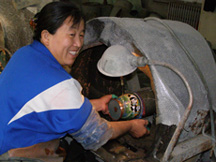 The artist selects his colors from 100 different colors available, and “paints” with an eyedropper filled with a mixture of color powders mixed with water. The piece will then be alternately painted and fired six times, polished, gilded, and then polished using an emery stone, a whet stone, and finally charcoal. There is a separate artist for each step of the process: one to curl and apply the wire, one to paint, one to fire, one to polish, etc. Artists attend a cloisonné school for 3-4 years and study with Old Masters in order to learn this highly skilled art. It takes one person one month to finish a cloisonné ware vase.
The artist selects his colors from 100 different colors available, and “paints” with an eyedropper filled with a mixture of color powders mixed with water. The piece will then be alternately painted and fired six times, polished, gilded, and then polished using an emery stone, a whet stone, and finally charcoal. There is a separate artist for each step of the process: one to curl and apply the wire, one to paint, one to fire, one to polish, etc. Artists attend a cloisonné school for 3-4 years and study with Old Masters in order to learn this highly skilled art. It takes one person one month to finish a cloisonné ware vase.
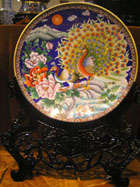 Beijing Binbin Handicraft Group
Beijing Binbin Handicraft Group
Dingfuhuangzhuang
Changping
Beijing 102206
People’s Republic of China
Telephone: +86 10 697 32 607
Fax: +86 10 697 32 942
Email: Xuxiaoxissl@sohu.com
www.BBHG.com
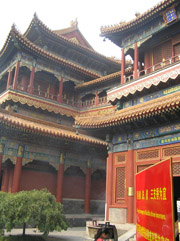 Our next visit was to Yonghe Gong Lamasery, built in 1694 as the residence of the Qing Dynasty Prince Yong. In 1725, Emperor Yong Zheng made the residence into a palace and named it “Yonghe Gong,” which means harmony and peace. In 1744, Emperor Qian turned the palace into a lamasery, which is the largest Tibetan Buddist Lama Temple in Beijing.
Our next visit was to Yonghe Gong Lamasery, built in 1694 as the residence of the Qing Dynasty Prince Yong. In 1725, Emperor Yong Zheng made the residence into a palace and named it “Yonghe Gong,” which means harmony and peace. In 1744, Emperor Qian turned the palace into a lamasery, which is the largest Tibetan Buddist Lama Temple in Beijing.
The Yonghe Gong Lamasery, also called the Lama Temple, was an amazing place to visit. Of particular interest, is the 26-meter statue of Maitreya Buddha, carved from a single trunk of white sandalwood, and covered with gold plate.
In Harmony Hall, built in 1694 AD, there is a central altar with three Buddhas; the center Buddha represents the present, the one to the right is the past, and the one to the left is the future. On the altar, there are eight Buddhist symbols, called treasures. We visited each of the buildings of the Lama Temple, and found the experience to be very informative and moving. Hours: 9:00 am – 4:00 pm, and is closed on Monday. Admission is charged.
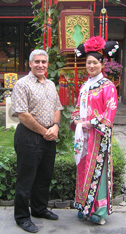 China is an ancient country steeped with tradition. We had lunch at the Baijia Dazhaimen Restaurant, (Bai Family Mansion) which was like taking a step back in time. Upon entering the restaurant, a staff member dressed in beautiful traditional Manchu clothing met us with the ancient greeting “Nin Jixiang” (Good luck to you.), and led us through the attractive Qing Dynasty style gardens to an elaborate intimate private room, where we dined on Imperial court cuisine.
China is an ancient country steeped with tradition. We had lunch at the Baijia Dazhaimen Restaurant, (Bai Family Mansion) which was like taking a step back in time. Upon entering the restaurant, a staff member dressed in beautiful traditional Manchu clothing met us with the ancient greeting “Nin Jixiang” (Good luck to you.), and led us through the attractive Qing Dynasty style gardens to an elaborate intimate private room, where we dined on Imperial court cuisine.
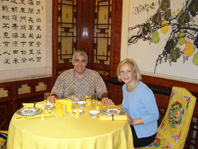 Our private dining room overlooked the gardens, and featured carved wood walls, a painted chrysanthemum on the ceiling, a painted lantern with red tassels, a round table decorated with a yellow tablecloth and pretty yellow and blue patterned china, and embroidered yellow fabric covered chairs.
Our private dining room overlooked the gardens, and featured carved wood walls, a painted chrysanthemum on the ceiling, a painted lantern with red tassels, a round table decorated with a yellow tablecloth and pretty yellow and blue patterned china, and embroidered yellow fabric covered chairs.
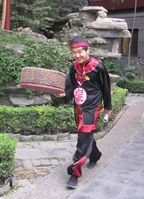 A strikingly attired staff member brought us hot towels to refresh us before we began our dining experience, which began as servers carried beautifully presented courses of aromatic and flavorful cuisine to our private dining room on large round silk domes. We eagerly waited as the servers removed the domes to uncover Sliced Celery and Lotus, Beef with Red and Green Peppers and Garlic in a Light and Spicy Chili Sauce, Thin Broccoli, Fish and Mushrooms in a Sweet Sauce, and steamed rice.
A strikingly attired staff member brought us hot towels to refresh us before we began our dining experience, which began as servers carried beautifully presented courses of aromatic and flavorful cuisine to our private dining room on large round silk domes. We eagerly waited as the servers removed the domes to uncover Sliced Celery and Lotus, Beef with Red and Green Peppers and Garlic in a Light and Spicy Chili Sauce, Thin Broccoli, Fish and Mushrooms in a Sweet Sauce, and steamed rice.
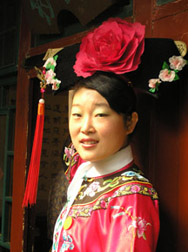 Dining at the Baijia Dazhaimen Restaurant (Bai Family Mansion) is a feast for all of the senses. After lunch, we strolled through the lush, fragrant gardens where traditional music played in the background in perfect harmony with the gracious ambience. The restaurant is open for Lunch and Dinner.
Dining at the Baijia Dazhaimen Restaurant (Bai Family Mansion) is a feast for all of the senses. After lunch, we strolled through the lush, fragrant gardens where traditional music played in the background in perfect harmony with the gracious ambience. The restaurant is open for Lunch and Dinner.
Baijia Dazhaimen Restaurant
15 Suzhou Street
Haidian District
Beijing 100080
People’s Republic of China
Telephone: (86 10) 6265 8851
Fax: (86 10) 8261 3048
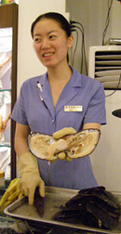 China is noted for its pearls, and we made a visit to the Pearl Market where we learned about the difference between freshwater and saltwater pearls. Freshwater oysters have rings, or bands, which designate the age of the oyster, in the same way that you can determine the age of a tree. While a saltwater oyster will only produce one pearl, a freshwater oyster is able to produce several pearls. The staff member opened a freshwater oyster and showed us several pearls that looked like little bumps, which she gently pried off using a knife, and she gave us a pearl as a little souvenir of our visit. Freshwater pearls come in a wide range of colors: white, pink, lavender, and black, depending on the minerals in the water. In addition to jewelry, small pearls are also used to make pearl powder and cosmetics.
China is noted for its pearls, and we made a visit to the Pearl Market where we learned about the difference between freshwater and saltwater pearls. Freshwater oysters have rings, or bands, which designate the age of the oyster, in the same way that you can determine the age of a tree. While a saltwater oyster will only produce one pearl, a freshwater oyster is able to produce several pearls. The staff member opened a freshwater oyster and showed us several pearls that looked like little bumps, which she gently pried off using a knife, and she gave us a pearl as a little souvenir of our visit. Freshwater pearls come in a wide range of colors: white, pink, lavender, and black, depending on the minerals in the water. In addition to jewelry, small pearls are also used to make pearl powder and cosmetics.
 We also learned how to distinguish real pearls from artificial pearls. If you rub two real pearls together, they will make a sound like sandpaper. After, when you rub the pearls on your hand, you will see some powder, but without any color removed from the pearls.
We also learned how to distinguish real pearls from artificial pearls. If you rub two real pearls together, they will make a sound like sandpaper. After, when you rub the pearls on your hand, you will see some powder, but without any color removed from the pearls.
We took a Dragon boat to visit the Summer Palace and walked through the 728-meter corridor which features 10,000 historical paintings depicting classical stories including the Monkey King, Rascal Beside the Water, and Remnants of a Dream.

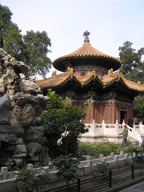 The Summer Palace, covers 2.9 million square meters, and has the largest imperial gardens in China. We enjoyed strolling the beautiful gardens with fascinating natural rock formations from the sea, and seeing the museum. We also saw the impressive Marble Boat, built in 1775, burned in 1860, and rebuilt by the Empress Dowager Cixi in 1893. In 1998, it received a UNESCO World Cultural Heritage designation. Hours: 9:00 am – 4:00 pm. Admission is charged.
The Summer Palace, covers 2.9 million square meters, and has the largest imperial gardens in China. We enjoyed strolling the beautiful gardens with fascinating natural rock formations from the sea, and seeing the museum. We also saw the impressive Marble Boat, built in 1775, burned in 1860, and rebuilt by the Empress Dowager Cixi in 1893. In 1998, it received a UNESCO World Cultural Heritage designation. Hours: 9:00 am – 4:00 pm. Admission is charged.
After four nights of experiencing Beijing in the Badaling Mountains at the Commune By The Great Wall Kempinski, it was time to see Beijing from the city centre, at the Commune By The Great Wall Kempinski’s sister hotel, the Kempinski Hotel Beijing Lufthansa Center.
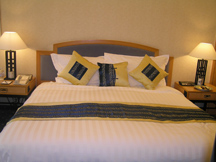 The 526-room and suite Kempinski Hotel Beijing Lufthansa Center is a beautiful oasis perfectly located in the city center. Enter the spacious red and black marble reception area lined with bamboo trees in attractive red pots, with soaring glass atrium, and you feel that you are far removed from the hustle and bustle of Beijing. We stayed in a beautiful Executive Floor guestroom, where we received personalized butler service in the Executive Lounge.
The 526-room and suite Kempinski Hotel Beijing Lufthansa Center is a beautiful oasis perfectly located in the city center. Enter the spacious red and black marble reception area lined with bamboo trees in attractive red pots, with soaring glass atrium, and you feel that you are far removed from the hustle and bustle of Beijing. We stayed in a beautiful Executive Floor guestroom, where we received personalized butler service in the Executive Lounge.
The hotel has seven restaurants under the responsibility of Executive Chef Wolfgang Schmelcher where guests can experience regional as well as international cuisine. We had a wonderful dinner at the Dragon Palace Restaurant, which features Chinese and Cantonese cuisine. We had a delicious lunch at new and very trendy Kranzler’s Restaurant & Bar, which features a buffet as well as a la carte dining. We had traditional tea in the Rendezvous Bar & Lounge, the perfect place to enjoy tea and snacks, sip a cocktail or a glass of wine, and listen to piano music, and we had a tasty authentic Italian dinner at Trattoria La Gondola. Their German delicatessen, Kempi Deli, features made-on-the premises homemade breads, pretzels, pastries, and sausages, ice cream, and other goodies. Paulaner Brauhaus brings Bavaria to Beijing, with traditional German cuisine and their own microbrewery where the brewmaster produces up to 500 liters of beer per day. Honzen Restaurant features Japanese cuisine and sushi.
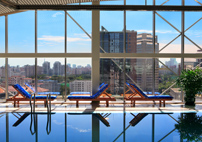 Exercise aficionados will appreciate the rooftop indoor heated swimming pool and fitness center with lots of natural light where you can “sightsee” while exercising with a panoramic view of Beijing. I loved beginning each day by swimming laps in the pool.
Exercise aficionados will appreciate the rooftop indoor heated swimming pool and fitness center with lots of natural light where you can “sightsee” while exercising with a panoramic view of Beijing. I loved beginning each day by swimming laps in the pool.
There are boutiques located in the hotel, and even an upscale shopping complex, Beijing Lufthansa Shopping Center connected to the Kempinski Hotel Beijing Lufthansa Center so guests can go shopping without even stepping outside of the hotel. The hotel is located in the highly desirable business and diplomatic quarter of Beijing and is only 20-minutes from the Beijing International Capital Airport.
For additional information on the Kempinski Hotel Beijing Lufthansa Center, please read the articles in the Hotels and Resorts, Restaurants, and Chefs’ Recipes sections.
Kempinski Hotel Beijing Lufthansa Center
50 Liangmaqiao Road
Chaoyang District
Beijing 100016
People’s Republic of China
Telephone: (86 10) 6465 3888
Fax: (86 10) 6465 3366
Toll-Free: (00 800) 426 313 55 (Europe)
Toll-Free: 1 800 426 3135 (North America)
Email: reservations.khblc@Kempinski.com
Website: www.Kempinski-Beijing.com
We visited the Arthur M. Sackler Museum of Art & Anthropology on the grounds of the prestigious Peking University. The museum has a fascinating collection of 10,000 objects spanning 280,000 years. Hours: 9:00 am – 4:30 pm, except holidays. Admission is charged.
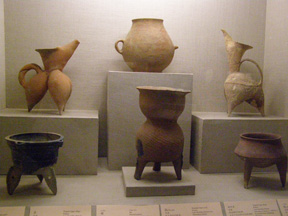
Zhongguancun Electronics Center is where you can find anything you might want in the form of electronics. This area is known as Beijing’s “Silicon Valley.” Imagine a multi-floor “department” store where you purchase the latest in electronics from cameras, video equipment, laptops, telephones, and much more. I really had to keep an eye on Edward so that he would not disappear on me in his search for new “toys.”
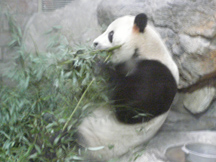 We visited the Beijing Zoo, which opened in 1908, and is the oldest and largest zoo in Asia Pacific. A trip to China would not be complete without visiting the Panda Pavilion to see these adorable creatures. If you think Giant Pandas are cute in pictures, wait until you see them “live” playing or eating their bamboo. We could have stayed here for hours watching them play.
We visited the Beijing Zoo, which opened in 1908, and is the oldest and largest zoo in Asia Pacific. A trip to China would not be complete without visiting the Panda Pavilion to see these adorable creatures. If you think Giant Pandas are cute in pictures, wait until you see them “live” playing or eating their bamboo. We could have stayed here for hours watching them play.
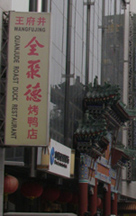 One of the gastronomic specialties of Beijing is roasted Peking duck, also called Beijing duck. We enjoyed a traditional Peking duck dinner at Quanjude Duck House, a time-honored company established in 1864. The roasted Peking duck dinner began with intricately slices of duck served with thin pancakes and mixed vegetables, and ended with duck soup.
One of the gastronomic specialties of Beijing is roasted Peking duck, also called Beijing duck. We enjoyed a traditional Peking duck dinner at Quanjude Duck House, a time-honored company established in 1864. The roasted Peking duck dinner began with intricately slices of duck served with thin pancakes and mixed vegetables, and ended with duck soup.
Quanjude Duck House
32 Qianmen Dajie
Beijing 100078
People’s Republic of China
Telephone: (86 10) 6511 2418
We visited Tiananmen Square, the world’s largest public square covering an area of 440,000 square meters, saw the Gate of Heavenly Peace, Tiananmen Gate Tower, Monument to the People’s Heroes, Great Wall of the People, and Chairman Mao Memorial Hall.
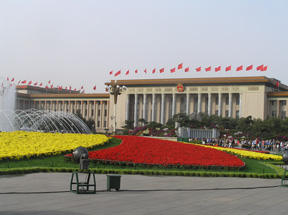
Beijing is already getting ready for the 2008 Olympics and we saw two adorable Olympics mascot sculptures in the gardens at Tiananmen Square.

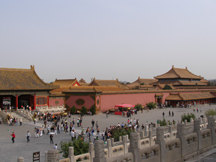 We passed through the Gate of Heavenly Peace into the Palace Museum, formerly known as the Purple Forbidden City, built between 1406-1420, where 24 emperors ruled for 492 years. The Forbidden City, surrounded by a 10-meters high wall, and a 52-meter moat, covers an area of 720,000 square meters. The colorful architecture is amazing, and the Palace Museum has a fascinating collection of over 1 million objects on display.
We passed through the Gate of Heavenly Peace into the Palace Museum, formerly known as the Purple Forbidden City, built between 1406-1420, where 24 emperors ruled for 492 years. The Forbidden City, surrounded by a 10-meters high wall, and a 52-meter moat, covers an area of 720,000 square meters. The colorful architecture is amazing, and the Palace Museum has a fascinating collection of over 1 million objects on display.
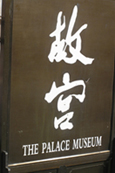 Allow yourself enough time to truly appreciate the Palace Museum. Hours: daily from 8:30 am – 4:30 pm with extended hours until 5:00 pm from April 16 – October 15. Admission is charged.
Allow yourself enough time to truly appreciate the Palace Museum. Hours: daily from 8:30 am – 4:30 pm with extended hours until 5:00 pm from April 16 – October 15. Admission is charged.
Palace Museum
Jingshan Jianjie
Beijing 100009
People’s Republic of China
Telephone: (86 10) 6513 2255
Fax: (86 10) 6512 3119
www.DPM.org.cn
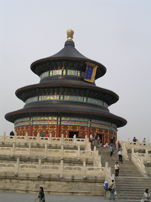 Temple of Heaven, built in 1420, is where the Emperors of the Ming and Qing Dynasties worshipped Heaven and prayed for good harvests. The complex is 2.73 million square meters and is the largest temple complex in China. In 1998, it received a UNESCO World Heritage site designation. Hours: 7:00 am – 7:30 pm (winter) and 5:00 am – 9:30 pm (summer). Admission is charged.
Temple of Heaven, built in 1420, is where the Emperors of the Ming and Qing Dynasties worshipped Heaven and prayed for good harvests. The complex is 2.73 million square meters and is the largest temple complex in China. In 1998, it received a UNESCO World Heritage site designation. Hours: 7:00 am – 7:30 pm (winter) and 5:00 am – 9:30 pm (summer). Admission is charged.
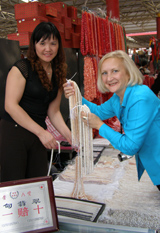 If you enjoy treasure hunting, you will definitely enjoy visiting the Panjiayuan Market nicknamed the “Dirt Market.” Here you can find old and new treasures, antiques as well as reproductions, handicrafts, carpets, silk goods, clothing, jade, pearls, tools, and much more. Be prepared to bargain and to have a great time. We loved roaming the 3,000 stall market and bargaining for our purchases so much that we returned the following day so that we could purchase additional silk products and pearl jewelry. The Panjiayuan Market is located on the southeast corner of Third Ring Road (east of Longtan Park), and is open Saturday and Sunday from 7:00 am – 5:00 pm.
If you enjoy treasure hunting, you will definitely enjoy visiting the Panjiayuan Market nicknamed the “Dirt Market.” Here you can find old and new treasures, antiques as well as reproductions, handicrafts, carpets, silk goods, clothing, jade, pearls, tools, and much more. Be prepared to bargain and to have a great time. We loved roaming the 3,000 stall market and bargaining for our purchases so much that we returned the following day so that we could purchase additional silk products and pearl jewelry. The Panjiayuan Market is located on the southeast corner of Third Ring Road (east of Longtan Park), and is open Saturday and Sunday from 7:00 am – 5:00 pm.
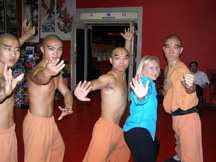 Beijing is a city with many cultural offerings. We went to see the Legend of Kung Fu at The Red Theatre, and loved this spectacular show depicting the life of a young boy who finally reaches enlightenment through mastering kung fu and Zen. The performance was extremely well done, and the kungfu moves literally had the audience sitting on the edge of their seats. In addition to the program detailing the show, there was a marquee above the stage, which explained each of the scenes in Chinese as well as in English. There are two performances daily.
Beijing is a city with many cultural offerings. We went to see the Legend of Kung Fu at The Red Theatre, and loved this spectacular show depicting the life of a young boy who finally reaches enlightenment through mastering kung fu and Zen. The performance was extremely well done, and the kungfu moves literally had the audience sitting on the edge of their seats. In addition to the program detailing the show, there was a marquee above the stage, which explained each of the scenes in Chinese as well as in English. There are two performances daily.
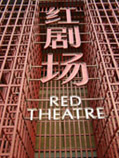 The Red Theatre
The Red Theatre
44Xing Fu Da Jie
Chongwen District
Beijing
People’s Republic of China
Telephone: (86 10) 6714 2473
Fax: (86 10) 6714 0497
www.LegendofKungfu.com
 Another important cultural experience of China is a visit to the teahouses. We went to the Laoshe Teahouse, founded in 1988, which focuses on Beijing Style Culture, Tea Culture, Theatre Culture, and Food Culture of China. The Laoshe Teahouse combines opera performance, music, and intriguing tea art performance. Since opening, the Laoshe Teahouse has hosted 46 foreign leaders including former United States President George Bush, former Russian Prime Minister Primakov, former German Prime Minister Kohl, Former Japanese Premiere Toshiki Kaifu, Former Danish Premiere Rasmussen, and Cambodian Premiere Hun Sen.
Another important cultural experience of China is a visit to the teahouses. We went to the Laoshe Teahouse, founded in 1988, which focuses on Beijing Style Culture, Tea Culture, Theatre Culture, and Food Culture of China. The Laoshe Teahouse combines opera performance, music, and intriguing tea art performance. Since opening, the Laoshe Teahouse has hosted 46 foreign leaders including former United States President George Bush, former Russian Prime Minister Primakov, former German Prime Minister Kohl, Former Japanese Premiere Toshiki Kaifu, Former Danish Premiere Rasmussen, and Cambodian Premiere Hun Sen.
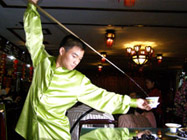 The night that we attended the Laoshe Teahouse the program included a folk music performance, Peking Opera highlights, Tea Ceremony, Face-Changing of the Sichuan Opera, Chinese Kung fu, and much more.
The night that we attended the Laoshe Teahouse the program included a folk music performance, Peking Opera highlights, Tea Ceremony, Face-Changing of the Sichuan Opera, Chinese Kung fu, and much more.
Laoshe Teahouse
Quianmen Xidajie, Building 3, 3rd floor
Beijing 100051
People’s Republic of China
Telephone: (86 10) 6303 6830
Email: office@laosheteahouse.com
www.LaosheTeaHouse.com
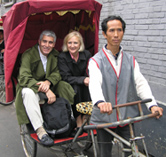 To experience the world of old Beijing, it is interesting to visit the Hutongs, which are the traditional communal neighborhoods. We took a Hutong tour by Pedicab in the Houhai District near the Forbidden City, followed by a nice lunch in a private home in the Hutong, where our hostess was a very interesting and charming woman.
To experience the world of old Beijing, it is interesting to visit the Hutongs, which are the traditional communal neighborhoods. We took a Hutong tour by Pedicab in the Houhai District near the Forbidden City, followed by a nice lunch in a private home in the Hutong, where our hostess was a very interesting and charming woman.
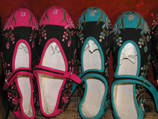 After lunch, we strolled along the water where we watched the boats, walked the winding streets browsing in many of the small shops soaking in the old-world ambience of the Hutong, and purchased a few souvenirs along the way.
After lunch, we strolled along the water where we watched the boats, walked the winding streets browsing in many of the small shops soaking in the old-world ambience of the Hutong, and purchased a few souvenirs along the way.
 China is noted for jade, and we made a visit to the Long Di Superior Jade Gallery. We were amazed watching the artisans creating carved jade jewelry, intricately carved moving balls that are inside of other carved moving balls, and other exquisite pieces. After watching the artisans, we had a tasty lunch in their restaurant, followed by some shopping in the gallery.
China is noted for jade, and we made a visit to the Long Di Superior Jade Gallery. We were amazed watching the artisans creating carved jade jewelry, intricately carved moving balls that are inside of other carved moving balls, and other exquisite pieces. After watching the artisans, we had a tasty lunch in their restaurant, followed by some shopping in the gallery.
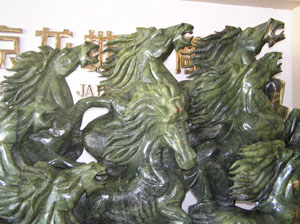
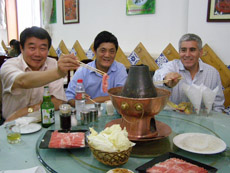 Another interesting restaurant that we went to was the time-honored restaurant, Dong Lai Shun Restaurant, which opened in 1903, for a traditional Mongolian Hot Pot lunch. Mr. Gao Feng, our driver, and Mr. Jia Lu, our guide, joined us for lunch, and explained how to use the special copper hot pot set in boiling water to cook the thinly shaved slices of mutton. Diners place shaved mutton, Chinese cabbage leaves, and rice noodles in the boiling water to cook. The food is cooked very quickly and the meat is very tender.
Another interesting restaurant that we went to was the time-honored restaurant, Dong Lai Shun Restaurant, which opened in 1903, for a traditional Mongolian Hot Pot lunch. Mr. Gao Feng, our driver, and Mr. Jia Lu, our guide, joined us for lunch, and explained how to use the special copper hot pot set in boiling water to cook the thinly shaved slices of mutton. Diners place shaved mutton, Chinese cabbage leaves, and rice noodles in the boiling water to cook. The food is cooked very quickly and the meat is very tender.
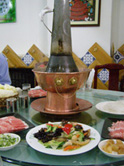 In addition to the mutton, we also enjoyed plates of many specially prepared dishes. Vegetable dishes included delicious braised eggplant, and small cabbages with mushrooms. Sweets followed, including white gelatinous “snowball” rolls filled with diced fruit, multi-layer sesame seed cakes, steamed sticky rice cakes, and an interesting sweet called a “rolling donkey” which was sweet bean paste inside sticky rice, accompanied by Yanjingbier, a Chinese beer.
In addition to the mutton, we also enjoyed plates of many specially prepared dishes. Vegetable dishes included delicious braised eggplant, and small cabbages with mushrooms. Sweets followed, including white gelatinous “snowball” rolls filled with diced fruit, multi-layer sesame seed cakes, steamed sticky rice cakes, and an interesting sweet called a “rolling donkey” which was sweet bean paste inside sticky rice, accompanied by Yanjingbier, a Chinese beer.
Dong Lai Shun Restaurant
198 Wangfujing Dajie
5th Floor, New Dong’an Market
Beijing
People’s Republic of China
Telephone: (86 10) 6528 0932
Make sure to make time in your visit to Beijing for shopping on Wangfujing Pedestrian Street. Here, you can find almost anything that you would like to purchase on this long street of shops and department stores.
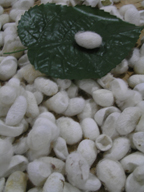 We visited the Beijing Yuanlong Silk Corporation, Ltd., founded in 1932, and let me forewarn you, this time-honored store is wonderful, and it is very hard to resist the urge to purchase half of the store, which we very nearly did. The store is the perfect place to witness the art of silk making, and after watching the women demonstrate this fascinating art, we purchased a luxurious silk comforter and silk duvet set, and made a few other purchases as well.
We visited the Beijing Yuanlong Silk Corporation, Ltd., founded in 1932, and let me forewarn you, this time-honored store is wonderful, and it is very hard to resist the urge to purchase half of the store, which we very nearly did. The store is the perfect place to witness the art of silk making, and after watching the women demonstrate this fascinating art, we purchased a luxurious silk comforter and silk duvet set, and made a few other purchases as well.
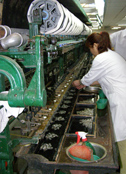 Silk is a truly remarkable product that begins simply as a moth’s cocoon. A silk moth has a two-month life cycle, and will lay its eggs and then dies. Workers gather the cocoons, put the cocoons in water to soften them, and then pull the cocoons into a single strand. Each cocoon produces a single strand that is over 1,400 meters (4,593 feet) in length. Eight – ten strands are spun together to create one thread that is thick and strong.
Silk is a truly remarkable product that begins simply as a moth’s cocoon. A silk moth has a two-month life cycle, and will lay its eggs and then dies. Workers gather the cocoons, put the cocoons in water to soften them, and then pull the cocoons into a single strand. Each cocoon produces a single strand that is over 1,400 meters (4,593 feet) in length. Eight – ten strands are spun together to create one thread that is thick and strong.
 Nothing is wasted during the silk production; after the cocoon is removed, the worm inside the cocoon is high in protein can be cooked and eaten. Small worms are used for medicinal uses (arthritis and rheumatism), as well as for cosmetics.
Nothing is wasted during the silk production; after the cocoon is removed, the worm inside the cocoon is high in protein can be cooked and eaten. Small worms are used for medicinal uses (arthritis and rheumatism), as well as for cosmetics.
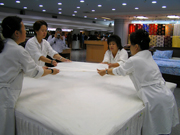 A double cocoon is very rare, and only occurs in China. To create the silk quilts, workers stretch double cocoons over a small frame, and then stretch it over a larger frame, and finally, four workers stretch the cocoons into a larger square.
A double cocoon is very rare, and only occurs in China. To create the silk quilts, workers stretch double cocoons over a small frame, and then stretch it over a larger frame, and finally, four workers stretch the cocoons into a larger square.
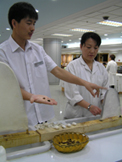 Summer quilts have 80 layers, and use 1600 double cocoons. The advantage of silk quilts is that they produce no dust, are natural, and contain no allergens. All of the quilts are hand-stretched, and may be dry-cleaned or put in the sun to refresh them. A silk cover uses a single cocoon, and may be washed in cold water or dry cleaned.
Summer quilts have 80 layers, and use 1600 double cocoons. The advantage of silk quilts is that they produce no dust, are natural, and contain no allergens. All of the quilts are hand-stretched, and may be dry-cleaned or put in the sun to refresh them. A silk cover uses a single cocoon, and may be washed in cold water or dry cleaned.
 In addition to silk comforters, duvets, tapestries, silk fabric, and ready-to-wear clothing, there are expert tailors at the company that will create custom clothing to suit the client. While I was busy shopping for the silk comforter and silk duvet cover, Edward went to have “just a look” at the Tailor Shop and when I found him an hour later, he had already been measured for three suits, and three pairs of trousers, which would be made and delivered directly to our hotel.
In addition to silk comforters, duvets, tapestries, silk fabric, and ready-to-wear clothing, there are expert tailors at the company that will create custom clothing to suit the client. While I was busy shopping for the silk comforter and silk duvet cover, Edward went to have “just a look” at the Tailor Shop and when I found him an hour later, he had already been measured for three suits, and three pairs of trousers, which would be made and delivered directly to our hotel.
Beijing Yuanlong Silk Corporation, Ltd.
55 Tiantan Road
Chongwen District
Beijing 10062
People’s Republic of China
Telephone: (86 10) 6705 2451
Fax: (86 10) 6705 2453
We returned to our hotel and said a fond farewell “Zai Jian” to Mr. Gao Feng, and Mr. Jia Lu, who along with East Tours, were invaluable in helping us to fully experience the essence of Beijing.
In the evening, a tailor from the Beijing Yuanlong Silk Corporation, Ltd, brought Edward’s new suits and trousers for a first fitting, and stated that he would have the finished products delivered to us at 6:00 am.
We spent our last night in Beijing having a wonderful dinner at the Trattoria La Gondola at the Kempinski Hotel Beijing Lufthansa Center, and went to sleep with wonderful memories of our time in Beijing.
In the morning, as promised, Edward’s three new suits, and three pairs of trousers were delivered to our room. He tried them on and the fit was perfect, which was a fitting ending to a perfect time in Beijing.
Although I tried to capture the culture, history, and beauty of Beijing within this article, you really need to experience China for yourself to truly appreciate the country. Even after spending eight days in Beijing, we will need to return to in order to discover more of what this fascinating city has to offer.
Read other articles on China in the Hotels and Resorts, Restaurants, Chefs’ Recipes, Spas, and Adventures sections.
Important Information for traveling to China:
China requires that foreign visitors apply for a visa. For information on how to apply for a visa, please visit: www.China-Embassy.org.
The currency of China is the Renminbi (RMB) made of dollars called Yuan (pronounced kuan). Paper money is available in 1 Yuan, 5 Yuan, 10 Yuan, 50 Yuan, and 100 Yuan. It is a good idea to have 10 Yuan available, as larger notes are sometimes difficult for smaller shops to change. For one Yuan, there are 10 Jiao. Jiao is available in paper bank notes of 1 Jiao, 2 Jiao, and 5 Jiao, as well as coins: 1 Yuan, 1 Jiao, and 5 Jiao. At the time of our visit to China in October 2006, the exchange rate was approximately 8 Yuan to 1 US Dollar.
Tipping Guide: It is advisable to give money in an envelope at the end of a trip.
Bellman: $1 US per bag
Drivers: $2-$3 US for 2 people per trip (8-24 Yuan)
Room Service: $1 US
Hotel Maids: $1 US per day
Restaurants: Tipping is not required. If sign says, “tipping or service is appreciated,” tip 5% of total bill.
I find that it is always helpful to have some basic language knowledge when traveling.
The Chinese words and phrases are spelled in Pinyin, the official system.
|
Basic Vocabulary |
|
|
|
|
English |
Chinese (Pinyin) |
Pronunciation |
Chinese |
|
Hello/How are you? |
Ni Hao |
Knee How |
你好 |
|
Goodbye |
Zai Jian |
Jai Jian |
再见 |
|
Thank you |
Xie Xie |
Shei Shei |
谢谢 |
|
You’re welcome |
Bu Ke Qi |
Boo Ke Chee |
不客气 |
|
Yes |
Shi |
Shi, How, Dwei |
是 |
|
No |
Bu |
Bu |
不是 |
|
How much is it? |
Duo Shao Qian |
Dwo Shao Chi-an |
多少钱 |
|
No, I do not want it. |
Wo Bu Yao |
Bu Yao |
我不要 |
|
I like it. |
Wo Xi Huan |
Wo Shi Hwen |
我喜欢 |
|
I do not like it. |
Wo Bu Xi Huan |
Wo Bu Shi Hwen |
我不喜欢 |
|
Good |
Hao |
How |
好 |
|
Bad |
Bu Hao |
Boo How |
不好 |
|
Beautiful |
Mei Li |
May Lee |
美丽 |
|
Cute or lovely |
Ke Ai |
Ke Eye |
可爱 |
|
Precious |
Bao Bei |
Bow Bay |
宝贝 |
|
Hotel |
Bing Guan/Jiu Dian |
Bin-Guan/Jiu-Dian |
宾馆/酒店 |
|
Where is? |
Na Li |
Na Li |
哪里 |
|
I am lost. |
Wo Mi Lu Le |
Wo Mi Lu Le |
我迷路了 |
|
Health |
|
|
|
|
English
|
Chinese |
Pronunciation |
Chinese |
|
Ill |
Sheng Bing |
Sheng-Bing |
生病 |
|
Doctor |
Yi Sheng |
Yi-Sheng |
医生 |
|
Dentist |
Ya Yi |
Ya-Yi |
牙医 |
|
Allergic |
Guo Min |
Guo-Min |
过敏 |
|
Hospital |
Yi Yuan |
Yi-Yuan |
医院 |
|
Food |
|||
|
English
|
Chinese |
Pronunciation |
Chinese |
|
(Hen) Eggs |
Ji Dan |
Ji-Dan |
鸡蛋 |
|
Lamb |
Yang Rou |
Yang-Zo |
羊肉 |
|
Meat dishes |
Rou |
Zo |
肉 |
|
Pork |
Zhu Rou |
Ju-Zo |
猪肉 |
|
Roast Duck |
Kao Ya |
Kao-Ya |
烤鸭 |
|
Shrimp |
Xia |
Sha |
虾 |
|
Vegetables |
Shu Cai |
Shu-Tsai |
蔬菜 |
|
Vegetarian meal |
Su Cai |
Su-Shi |
素菜 |
|
Beverages
|
|||
|
English
|
Chinese |
Pronunciation |
Chinese |
|
Beer |
Pi Jiu |
Pi-Jiu |
啤酒 |
|
Coffee |
Ka Fei |
Ka-Fei |
咖啡 |
|
Juice (Apple) |
Ping Guo Zhi |
Ping-Guo-Ji |
苹果汁 |
|
Juice (Orange) |
Ju Zi Shui |
Ju-Tse-Ji |
橘子汁 |
|
Milk (Cow’s) |
Niu Nai |
Niu-Nai |
牛奶 |
|
Milk (Soy) |
Dou Jiang |
Dou-Jiang |
豆浆 |
|
Water (Mineral) |
Kuang Quan Shui |
Kuang-Chuan-Shui |
矿泉水 |
For information on the Commune By The Great Wall Kempinski, please visit: www.Kempinski-TheGreatWall.com, www.Commune.com.cn.
For information on the Kempinski Hotel Beijing Lufthansa Center, please visit: www.Kempinski-Beijing.com.
For information on East Tours, please visit: www.East-Tours.com.
© January 2007 Luxury Experience www.LuxuryExperience.com All rights reserved.

